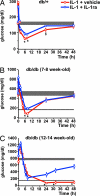IL-1 resets glucose homeostasis at central levels
- PMID: 17035503
- PMCID: PMC1635123
- DOI: 10.1073/pnas.0607076103
IL-1 resets glucose homeostasis at central levels
Abstract
Administration of IL-1beta results in a profound and long-lasting hypoglycemia. Here, we show that this effect can be elicited by endogenous IL-1 and is related to not only the capacity of the cytokine to increase glucose uptake in peripheral tissues but also to mechanisms integrated in the brain. We show that (i) blockade of IL-1 receptors in the brain partially counteracted IL-1-induced hypoglycemia; (ii) peripheral administration or induction of IL-1 production resulted in IL-1beta gene expression in the hypothalamus of normal and insulin-resistant, leptin receptor-deficient, diabetic db/db mice; (iii) IL-1-treated normal and db/db mice challenged with glucose did not return to their initial glucose levels but remained hypoglycemic for several hours. This effect was largely antagonized by blockade of IL-1 receptors in the brain; and (iv) when animals with an advanced Type II diabetes were treated with IL-1 and challenged with glucose, they died in hypoglycemia. However, when IL-1 receptors in the brains of these diabetic mice were blocked, they survived, and glucose blood levels approached those that these mice had before IL-1 administration. The prolonged hypoglycemic effect of IL-1 is insulin-independent and develops against increased levels of glucocorticoids, catecholamines, and glucagon. These findings, together with the present demonstration that this effect is integrated in the brain and is paralleled by IL-1beta expression in the hypothalamus, indicate that this cytokine can reset glucose homeostasis at central levels. Such reset, along with the peripheral actions of the cytokine, would favor glucose uptake by immune cells during inflammatory/immune processes.
Conflict of interest statement
The authors declare no conflict of interest.
Figures






Similar articles
-
Interleukin-1beta and insulin elicit different neuroendocrine responses to hypoglycemia.Ann N Y Acad Sci. 2009 Feb;1153:82-8. doi: 10.1111/j.1749-6632.2008.03981.x. Ann N Y Acad Sci. 2009. PMID: 19236331
-
Neuroendocrine and metabolic responses induced by interleukin-1.J Neurosci Res. 1987;18(1):172-8. doi: 10.1002/jnr.490180124. J Neurosci Res. 1987. PMID: 2824799
-
Interleukin-1 and glucose homeostasis: an example of the biological relevance of immune-neuroendocrine interactions.Horm Res. 1989;31(1-2):94-9. doi: 10.1159/000181095. Horm Res. 1989. PMID: 2785952
-
[Interleukin-1 and regulation of glucose homeostasis].Pathol Biol (Paris). 1993 Feb;41(2):178-86. Pathol Biol (Paris). 1993. PMID: 8392161 Review. French.
-
Brain-derived neurotrophic factor (BDNF) regulates glucose and energy metabolism in diabetic mice.Diabetes Metab Res Rev. 2002 May-Jun;18(3):185-91. doi: 10.1002/dmrr.290. Diabetes Metab Res Rev. 2002. PMID: 12112936 Review.
Cited by
-
Hypoglycemia-activated Hypothalamic Microglia Impairs Glucose Counterregulatory Responses.Sci Rep. 2019 Apr 17;9(1):6224. doi: 10.1038/s41598-019-42728-3. Sci Rep. 2019. PMID: 30996341 Free PMC article.
-
Hypoglycemia After Upper Gastrointestinal Surgery: Clinical Approach to Assessment, Diagnosis, and Treatment.Diabetes Metab Syndr Obes. 2020 Nov 19;13:4469-4482. doi: 10.2147/DMSO.S233078. eCollection 2020. Diabetes Metab Syndr Obes. 2020. PMID: 33239898 Free PMC article. Review.
-
Lipopolysaccharide-induced radical formation in the striatum is abolished in Nox2 gp91phox-deficient mice.J Neural Transm (Vienna). 2010 Jan;117(1):13-22. doi: 10.1007/s00702-009-0327-5. Epub 2009 Oct 29. J Neural Transm (Vienna). 2010. PMID: 19866338
-
Acute Inflammation Alters Brain Energy Metabolism in Mice and Humans: Role in Suppressed Spontaneous Activity, Impaired Cognition, and Delirium.J Neurosci. 2020 Jul 15;40(29):5681-5696. doi: 10.1523/JNEUROSCI.2876-19.2020. Epub 2020 Jun 8. J Neurosci. 2020. PMID: 32513828 Free PMC article.
-
Hypoglycemia: The neglected complication.Indian J Endocrinol Metab. 2013 Sep;17(5):819-34. doi: 10.4103/2230-8210.117219. Indian J Endocrinol Metab. 2013. PMID: 24083163 Free PMC article. Review.
References
Publication types
MeSH terms
Substances
Associated data
- Actions
- Actions
LinkOut - more resources
Full Text Sources
Molecular Biology Databases
Miscellaneous

